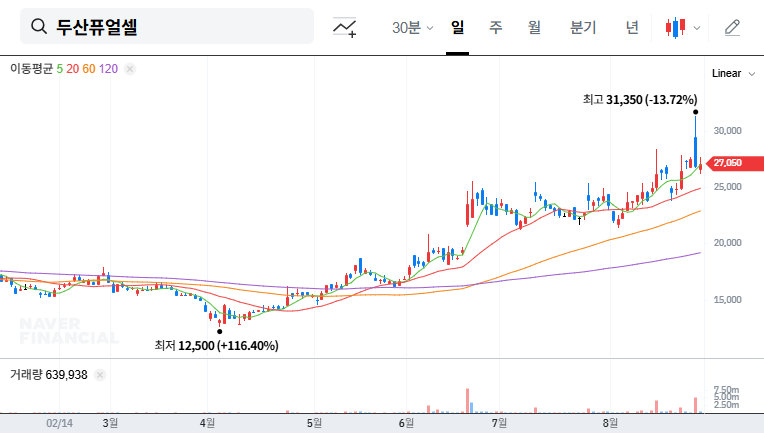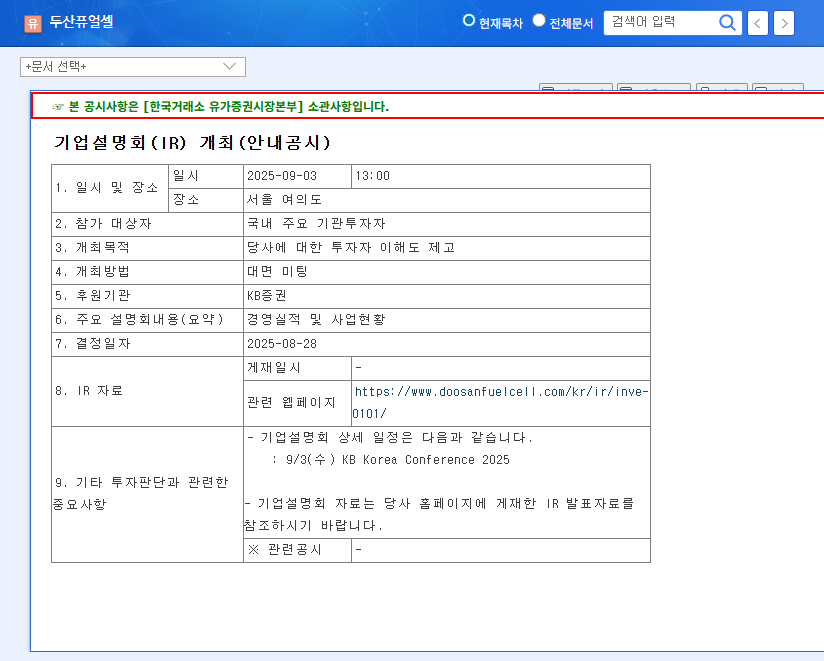
1. What Happened? H1 2025 Performance Review
Doosan Fuel Cell reported a decline in revenue for the first half of 2025, down 44.6% year-on-year to 228.2 billion KRW, with an operating loss of 13.5 billion KRW. This is attributed to a combination of factors, including rising raw material prices and increased production costs. Concerns about financial stability are also rising, as the debt-to-equity ratio increased to 153.8%.
2. Why Did This Happen? Reasons for Underperformance
The decline in revenue is primarily due to sluggish sales of fuel cell main units and long-term maintenance services. The operating loss is a result of decreased revenue coupled with rising raw material prices and increased production costs. Furthermore, the company’s high dependence on its top four clients (64.9% of total sales) makes it vulnerable to changes in demand from specific customers.
3. What’s the Plan? Key IR Focus and Expected Outcomes
Doosan Fuel Cell intends to use this IR to provide a clear explanation of its recent underperformance, highlighting its new business initiatives and future vision, including its entry into the eco-friendly commercial vehicle market (HyAxiom Motors acquisition) and securing SOFC technology. They are also expected to announce financial restructuring plans and risk management strategies. A successful IR could lead to stabilized investor sentiment, create momentum for a stock rebound, and attract potential investors.
4. What Should Investors Do? Investment Strategies
Investors should carefully review the information presented at the IR and assess the company’s future growth potential based on management’s explanations and responses during the Q&A session. Pay close attention to the progress of new businesses, profitability projections, and the feasibility of financial restructuring plans. It’s crucial to make investment decisions based on a comprehensive evaluation of both positive external factors, such as the growth potential of the hydrogen industry and government policy support, and the company’s fundamentals and future strategies.
What is Doosan Fuel Cell’s main business?
Doosan Fuel Cell manufactures and sells power generation fuel cell systems based on PAFC (Phosphoric Acid Fuel Cell) technology. They hold the largest market share in the domestic power generation fuel cell market. Recently, they have been diversifying their business by investing in eco-friendly commercial vehicles and SOFC (Solid Oxide Fuel Cell) technology development.
How did Doosan Fuel Cell perform in the first half of 2025?
Doosan Fuel Cell recorded revenue of 228.2 billion KRW (down 44.6% year-on-year) and an operating loss of 13.5 billion KRW in the first half of 2025.
What are the key things to watch for in this IR?
Key points of interest include the analysis of the reasons for underperformance, the presentation of new business initiatives and future vision, and the proposed financial restructuring plan. It’s especially important to look for information regarding the specific roadmap and profitability outlook for new businesses, such as the eco-friendly commercial vehicle venture and SOFC technology development.
